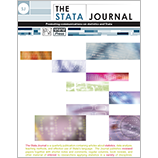The bmte command: Methods for the estimation of treatment effects when exclusion restrictions are unavailable
Ian McCarthy
Emory University
Atlanta, GA
[email protected]
|
Daniel Millimet
Southern Methodist University
Dallas, TX
Institute for the Study of Labor
Bonn, Germany
[email protected]
|
Rusty Tchernis
Georgia State University
Atlanta, GA
Institute for the Study of Labor
Bonn, Germany
National Bureau of Economic Research
Cambridge, MA
[email protected]
|
Abstract. We present a new Stata command, bmte (bias-minimizing treatment
effects), that implements two new estimators proposed in Millimet and Tchernis
(2013, Journal of Applied Econometrics 28: 982–1017) and designed
to estimate the effect of treatment when selection on unobserved variables
exists and appropriate exclusion restrictions are unavailable. In addition, the
bmteAnnals of Economic and Social Measurement 5:
475–492; 1979, Econometrica 47: 153–161); 2) a control
function approach outlined in Heckman, LaLonde, and Smith (1999, Handbook of
Labor Economics 3: 1865–2097) and Navarro (2008, The New Palgrave
Dictionary of Economics [Palgrave Macmillan]); and 3) a more recent
estimator proposed by Klein and Vella (2009, Journal of Applied
Econometrics 24: 735–762) that exploits heteroskedasticity for
identification. By implementing two new estimators alongside preexisting
estimators, the bmte command provides a picture of the average causal effects
of the treatment across a variety of assumptions. We present an example
application of the command following Millimet and Tchernis (2013, Journal of
Applied Econometrics 28: 982–1017).
View all articles by these authors:
Ian McCarthy, Daniel Millimet, Rusty Tchernis
View all articles with these keywords:
bmte, treatment effects, propensity score, unconfoundedness, selection on unobserved variables
Download citation: BibTeX RIS
Download citation and abstract: BibTeX RIS
|
